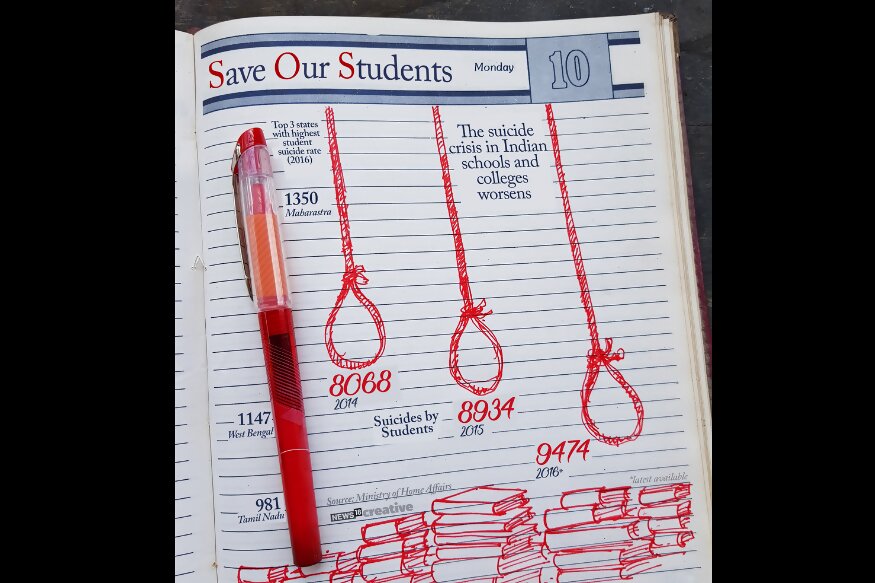
views
According to a WHO report, India has the highest number of depressed individuals in the world.
This means that one out of three individuals in India suffer from depression.
It is estimated, that 300 million people worldwide experience depression and are overcome by suicidal thoughts at some point. Statistics also reveal that 18% of the people who commit suicide have a history of failed suicide attempts in the past.
“These are shocking statistics. One must look ways to indentify symptoms amongst near and dear ones and help them by talking. Whether it is a serotonin or a dopamine imbalance, it is curable," said neurologist Dr Sonia Lal Gupta.
She further added that the brain is just like any other part of the body that can be treated and the only way to eradicate the stigma associated with mental health is “effective and active dialogues."
Need of the hour
Dr Samir Parikh, a psychiatrist who has devoted his life to mental health awareness believes that suicide is preventable. “The need of the hour is a national suicide prevention policy. It can help millions across the country," he said.
“The recent Mental Healthcare Act which was passed in 2017 decriminalized suicide, a much-appreciable act which encourages a sensitized approach to mental illnesses."
“ However, suicide prevention is a collective responsibility which is not simply restricted to policy making, but also requires creating awareness and sensitization towards the reporting of mental health, while at the same time making mental health services accessible and available to all," he added.
Nature of suicide
Historically and even today, discussions around suicide are highly stigmatized and shrouded with misconceptions.
In such a scenario, Dr Parikh believes that the onus of responsibility lies on the media to educate masses and spread awareness about suicide by bursting popular myths and misconceptions. “One of the most common myths is sometimes the barrier itself to preventing suicide: talking! Simply talking about suicide helps to not encourage suicides."
Dr Parikh explains that is this because more of than not, suicide is an impulsive decision, “that happens on the spur of the moment."
“In fact, it is a well thought out decision, which means that there could be many clear warning signs in people who could be contemplating suicide. Therefore, it is important to be vigilant to these signs, and to know how to respond to them," he added.
According to Dr Parikh, these signs are not only crucial insights to suicidal behavioral patterns, but are more importantly, desperate cries for help.
“Therefore, by spreading adequate awareness, it is actually possible to ensure a timely identification of individuals contemplating suicide and this can be a significant step towards the prevention of such incidents," he said.
Speaking to CNN-News18, Dr Sonia explained the need for parents to be vigilant of what their child might have access to online.
“A lot of shows on the internet can be harmful and drive teens to commit suicide. The impact of some shows on children and young adults can be detrimental. For example, a study conducted in JAMA in 2017 showed that the number of suicides linked to internet shows increased by 26% after their finale was aired. Hence, parents need to be involved with minors and their online consumption patterns," observed Dr Sonia Lal Gupta.
Some tell tale signs
Dr Sonia said that it’s important to not remain oblivious to certain symptoms such as fatigue, lack of appetite and headaches. “Go to an expert. It can be a sign of an onset of depression and is absolutely treatable through modern medication and cognitive behavioral therapy," she said.
“Watch out for people who give out signs and suddenly start feeling hopeless and get suicidal thoughts. When you identify such an individual, encourage him/her to get medical help as soon as possible," she added.

Do’s and Don’ts from the Desk of Dr Samir Parikh, Psychiatrist
-
1. Encourage reaching out.
An environment that encourages individuals to seek help is paramount, especially in light of the extreme stigma attached to mental health. In fact, it is our societal responsibility to work collaboratively to create an environment which de- stigmatizes suicide, and also provides for support within the community to enable such help- seeking behavior.
As a responsible individual of the society, all of us in our own respective capacity can make a difference by taking the initiative to talk about mental health problems and create awareness.
So, help should not be restricted to professional mental health experts, but each one of us can reach out to a friend or a family member to seek support, without being dismissive or insensitive towards the person.
2. Bust common misconceptions.
It is important to debunk common myths and misconceptions associated with suicide and self-harm. At the same time one must also think about the need of the hour to prevent such incidents in the future. Further, a complete understanding of such a phenomenon is necessary in order to sensitize masses towards the problem.
3. Spread awareness
It is important for us to realize that suicide is preventable. Therefore, creating awareness and educating people about the signs that could be indicative of some distress in someone who might be contemplating suicide is imperative.
4. Offer support
An adequate peer support and social network system, family support, school as well as community connectedness could serve as a major factor in lessening the risk of suicides. It is necessary to spread awareness about accessibility as well as referrals to appropriate professional help of counselors and psychiatrists.
5. Encourage skill building at every level, from schools, colleges, parents, to the entire community.
Toolkits for skill building are a must, especially for school children and teenagers. Efforts should be made to focus on building trust and rapport with them, so as to create an atmosphere of open communication that makes it easy for a person to share their innermost feelings.
Parent and community awareness programs need to be created to encourage parental notification and involvement. Forming a multi-component model for awareness building, preventive strategies as well as training for adequate intervention-based approaches are important.
6. Helplines
There exists a dire need of a student assistance/helpline program to identify risk factors for suicide, and the implementation of a prevention policy to promote adolescents’ resilience and healthy socio-emotional development.
Percentage share of various causes of suicides in order of contribution to people committing suicides:
Family problems [27.6%]
Illness [15.8%]
Marriage related issues [4.8%]
Love affairs [3.3%]
Bankruptcy or indebtedness [3.3%]
Drug abuse/addiction [2.7%]
Unemployment [2.0%]
Failure in examination [2.0%]



















Comments
0 comment